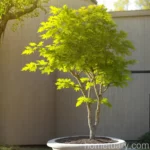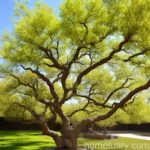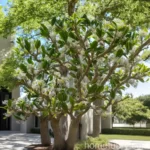English Oak (Quercus robur f. fastigiata): A Plant Scientist’s Comprehensive Guide
What is an English Oak (Quercus robur f. fastigiata)?
The English oak, scientifically known as Quercus robur f. fastigiata, is a captivating and majestic tree renowned for its tall, columnar growth habit. This fastigiate variety of the English oak offers various landscape and environmental benefits. In this comprehensive guide, we’ll delve into the culture, uses, care requirements, common diseases, pests, propagation, and other fascinating aspects of this remarkable plant. Whether you’re a gardening enthusiast, a professional landscaper, or simply an admirer of nature’s splendor, this guide is tailored to equip you with the knowledge and insights needed to nurture and appreciate the Quercus robur f. fastigiata.
Key Takeaways – English Oak (Quercus robur f. fastigiata)
Before we dive into the nuances of cultivating and caring for the English oak, let’s outline some key takeaways about this exceptional tree:
- Scientific Name: Quercus robur f. fastigiata
- Common Names: Fastigiate English oak, Tall columnar English oak
- Description: Upright English oak variety with a slender and columnar growth habit
- Cultivar: Quercus robur cultivar fastigiata
- Landscape Uses: Suitable for formal gardens, urban areas, windbreaks, and privacy screening
- Habitat: Adaptable to various soil preferences and can thrive in both urban and traditional landscapes
- Wildlife Value: Offers ecological significance as a wildlife habitat and supports biodiversity
- Seasonal Appeal: Showcases beautiful autumn colors, adding ornamental value to landscapes
- Disease Resistance: Exhibits robust resistance to pests and diseases, making it a low-maintenance choice for plant enthusiasts
Now that we have a brief overview, let’s delve into the specifics of cultivating and caring for the fastigiate English oak.
Culture
Water
The fastigiate English oak generally has moderate water requirements. While it can tolerate periods of drought once established, it thrives best in well-drained, moist soils. Adequate watering is essential, especially during the early stages of growth and establishment. However, it’s important to avoid waterlogging, as this can lead to root rot and other water-related issues. As a general guideline, providing the English oak with approximately 1 to 1.5 inches of water per week, either through rainfall or manual irrigation, is beneficial.
Sunlight
Adequate sunlight is crucial for the healthy development of the English oak. This tree flourishes in full sun to partial shade, making it adaptable to a wide range of light conditions. When planting, it’s important to consider a location that offers sufficient exposure to sunlight, promoting strong growth and enhancing the tree’s ornamental value, especially during the autumn season when its foliage turns into stunning shades of red and bronze.
Fertilizer
In terms of fertilizer requirements, the fastigiate English oak generally thrives in nutrient-rich soils. Applying a balanced fertilizer in spring, just before the growing season starts, can provide the tree with essential nutrients to support robust growth and development. Opt for a slow-release, high-quality fertilizer that is specifically formulated for deciduous trees, ensuring that it contains essential macronutrients such as nitrogen, phosphorus, and potassium.
Soil
The English oak is known for its adaptability to various soil types. It can thrive in loamy, sandy, or clay soils, provided they are well-drained. Before planting, it’s advisable to test the soil’s pH and structure to ensure it meets the tree’s requirements. A slightly acidic to neutral pH range (pH 6.0-7.5) is generally ideal for the Quercus robur f. fastigiata. Additionally, incorporating organic matter such as well-rotted compost into the soil can enhance its fertility and drainage capabilities, further supporting the tree’s growth.
Pruning
Pruning is an essential aspect of maintaining the fastigiate English oak’s attractive form and promoting its overall health. Proper pruning can help manage the tree’s growth, remove dead or diseased branches, and shape its canopy to achieve an aesthetically pleasing appearance. When pruning the English oak, it’s important to:
- Remove any dead, damaged, or diseased branches as soon as they are noticed to prevent potential spread of diseases and promote overall tree health.
- Conduct regular inspections to identify and address any structural issues, such as crossing or rubbing branches, to maintain the tree’s form and integrity.
- Avoid excessive pruning, especially during the growing season, to prevent stress and promote healthy growth.
The best time for pruning the fastigiate English oak is during the dormant season, typically in late winter or early spring before new growth emerges. This allows the tree to recover and heal from any pruning wounds before the active growing phase begins.
Propagation
Seed Propagation
Propagating the fastigiate English oak from seeds is a viable and rewarding method. Here’s a basic guide to seed propagation:
-
Seed Collection: Collect mature acorns from a healthy and well-established English oak tree during the autumn season. Look for acorns with intact caps and plump, fully-formed kernels.
-
Preparation: Remove the acorns from their caps and place them in a bucket of water. Discard any acorns that float, as they are likely to be infertile. Once the viable acorns have been selected, gently rinse them to remove any debris.
-
Stratification: To break the dormancy of the acorns, they require a period of cold stratification. This can be achieved by placing the acorns in a plastic bag filled with moist peat moss or vermiculite, then refrigerating them for approximately 60-90 days. Periodically check the moisture level to ensure it remains consistently damp but not waterlogged.
-
Planting: After the stratification period, prepare seedling containers filled with a well-draining potting mix. Plant the stratified acorns in the containers, ensuring they are covered with a layer of soil approximately twice the depth of the acorn’s size. It’s best to plant multiple acorns to increase the chances of successful germination.
-
Care: Keep the planted acorns in a sheltered outdoor location that receives partial sunlight. Ensure the soil remains consistently moist but not waterlogged. Germination typically occurs within a few weeks to several months, depending on environmental conditions and the quality of the acorns.
Vegetative Propagation
While seed propagation is one method, vegetative propagation techniques such as hardwood cuttings and grafting can also be employed to propagate the fastigiate English oak. These methods are often carried out by experienced gardeners and professionals to ensure the preservation of specific cultivars and desirable traits in new plantings.
Container Popularity
The fastigiate English oak is gaining popularity as a container plant, particularly for urban gardening and small-space landscaping. When grown in containers, this tree offers a vertical element without requiring a large planting area, making it a preferred choice for balconies, patios, and urban green spaces. Its columnar growth habit and ornamental value, especially during the fall season, make it an attractive addition to container gardens and landscape designs.
Common Diseases
While the English oak is generally known for its robust disease resistance, it can be susceptible to certain diseases under unfavorable conditions. Some of the common diseases that may affect the Quercus robur f. fastigiata include:
-
Oak Wilt: This fungal disease, caused by the pathogen Ceratocystis fagacearum, can lead to wilting, leaf discoloration, and eventual death of the tree. Oak wilt is often transmitted through root grafts between trees and by sap-feeding beetles carrying the fungal spores.
-
Powdery Mildew: Powdery mildew is a fungal disease that can affect the leaves of the English oak, causing a powdery white coating to develop on the foliage. While powdery mildew is not typically fatal to the tree, it can impact its aesthetic appeal and overall vigor.
-
Anthracnose: Anthracnose is a group of fungal diseases that can cause leaf spots, defoliation, and twig dieback in affected trees. It thrives in moist and cool conditions, making proper cultural practices such as improving air circulation and maintaining tree vigor important for disease prevention.
Disease Diagnosis
Diagnosing and addressing diseases in the fastigiate English oak requires careful observation and prompt intervention. If you notice any unusual symptoms such as wilting foliage, leaf spots, or abnormal growth, it’s essential to conduct a thorough evaluation to determine the cause. Consulting with a professional arborist or plant pathologist can aid in accurate disease diagnosis and the implementation of effective management strategies. Additionally, laboratory testing of plant samples or foliage can provide valuable insights into the presence of specific pathogens and diseases, guiding targeted treatment approaches.
Common Pests
The fastigiate English oak is generally resistant to major pest infestations. However, certain pests may occasionally pose a threat to the tree’s health and vitality. Some of the common pests that may affect the Quercus robur f. fastigiata include:
-
Oak Leafroller Moth: The caterpillars of the oak leafroller moth can feed on the foliage of the English oak, causing noticeable damage such as leaf rolling and skeletonization. While healthy trees can usually withstand minor feeding damage, severe infestations may warrant targeted intervention.
-
Gypsy Moth: The larvae of the gypsy moth are notorious for defoliating oak trees, including the English oak. Early detection and management of gypsy moth populations, such as through biological controls or targeted insecticide application, can help protect the tree from significant damage.
-
Scale Insects: Scale insects, such as oak scales, can infest the branches and twigs of the fastigiate English oak, potentially leading to weakened growth and vitality. Implementing appropriate integrated pest management strategies, including the introduction of natural predators and cultural controls, can help manage scale insect populations effectively.
Maintaining the overall health and vigor of the fastigiate English oak through proper cultural practices and regular monitoring can serve as a proactive defense against potential pest issues.
Botanist’s Tips
1. Selection of Planting Site
When planning to grow the fastigiate English oak, carefully assess the planting site to ensure it meets the tree’s requirements for sunlight, soil, and adequate space for vertical growth. A well-considered planting site can contribute to the tree’s overall health and longevity.
2. Mulching
Applying a layer of organic mulch around the base of the English oak can offer several benefits, including moisture retention, weed suppression, and soil insulation. Use organic materials such as shredded bark or compost, and ensure the mulch layer is spread evenly to avoid direct contact with the tree’s trunk.
3. Monitoring and Maintenance
Regularly monitor the fastigiate English oak for signs of stress, pests, diseases, or any other issues that may affect its health. Prompt maintenance and intervention can minimize potential problems and promote the tree’s well-being.
4. Pruning Considerations
When pruning the English oak, strive to maintain its natural form and structure while addressing any necessary corrective or preventive measures. Proper pruning practices contribute to the tree’s aesthetic appeal and overall vitality.
5. Environmental Stewardship
Embrace the role of the fastigiate English oak in promoting environmental stewardship and ecological sustainability. Consider its wildlife value, environmental benefits, and contributions to green spaces when incorporating it into landscape designs and urban environments.
Fun Facts
- The English oak (Quercus robur) has been revered in folklore, literature, and cultural traditions for centuries, symbolizing strength, endurance, and resilience.
- Mature English oak trees can support a diverse array of wildlife, including birds, insects, and small mammals, contributing to biodiversity in their ecosystems.
- The wood of the English oak is valued for its strength and durability, often used in furniture-making, construction, and shipbuilding.
- Traditional uses of English oak acorns include processing them into flour for culinary purposes and as a food source for wildlife.
Links to External Resources
For additional information and resources related to the fastigiate English oak, consider exploring the following links:
- Royal Horticultural Society – Quercus robur f. fastigiata
- Missouri Botanical Garden – Quercus robur f. fastigiata
- The Morton Arboretum – English Oak Cultivars
- University of Florida IFAS Extension – Quercus robur: English Oak
With the wealth of knowledge and insights provided in this guide, you are well-equipped to appreciate, cultivate, and care for the stunning Quercus robur f. fastigiata. Whether you’re a beginner gardener or seasoned arborist, the fastigiate English oak offers boundless possibilities for landscape enhancement, ecological stewardship, and the celebration of nature’s enduring beauty.















